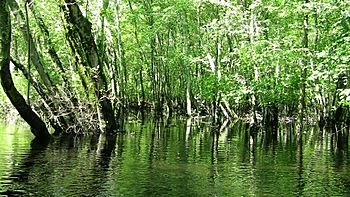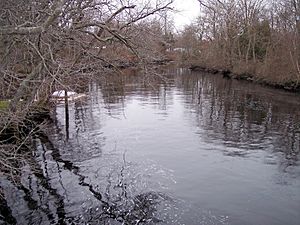Great Egg Harbor River facts for kids
Quick facts for kids Great Egg Harbor River |
|
|---|---|

"Shore" of the Great Egg Harbor River between Penny Pot and Weymouth Furnace
|
|
| Type: | Scenic, Recreational |
| Designated: | October 27, 1992 |
The Great Egg Harbor River is a 55.0-mile-long (88.5 km) river located in southern New Jersey, United States. It's one of the main rivers flowing through the beautiful and mostly untouched Pinelands. This river drains about 308 square miles (800 km2) of wetlands into the Atlantic Ocean at a place called Great Egg Harbor. The river gets its name from this bay.
The name "Great Egg Harbor" comes from a Dutch explorer named Cornelius Jacobsen Mey. In 1614, he explored the area and found the meadows along the river filled with so many shorebird and waterfowl eggs. He called it "Eyren Haven," which means "Egg Harbor." Today, the National Park Service thinks this area is one of the top 10 places in North America for birding (watching birds!).
About the Great Egg Harbor River

The Great Egg Harbor River starts in the suburbs southeast of Camden, near Berlin. It generally flows towards the southeast, passing south of the Atlantic City Expressway. The river finally reaches Great Egg Harbor, which is about 5 miles (8 km) southwest of Atlantic City.
The last 10 miles (16 km) of the river are like a river mouth that boats can use. This part is navigable all the way to Mays Landing. Another river, the Tuckahoe River, also flows into Great Egg Harbor, just south of where the Great Egg Harbor River enters.
A River with History
Before Europeans arrived in the 1700s, the Lenape people lived along the Great Egg Harbor River. During the American Revolutionary War, the river's mouth was a safe place for privateers (private ships allowed to attack enemy ships).
The river area also had "bog iron" (a type of iron found in bogs). This iron was used to make cannonballs! Because of this, factories were built along the river to make iron, glass, and bricks. These factories were active until the mid-1800s.
A Special River for Nature
In 1992, the United States Congress decided that 129 miles (208 km) of the Great Egg Harbor River and its smaller streams were special. They named it the Great Egg Harbor Scenic and Recreational River. This makes it part of the National Wild and Scenic Rivers System.
It's the longest river in the Pinelands that you can canoe on. You can paddle for about 47 miles (76 km) from New Brooklyn, near Route 536, all the way to Beesley's Point.
The river is famous for its "cedar water," which looks like tea. This color comes from the iron and tannin (a natural substance) from fallen cedar leaves along the river. This environment is perfect for many waterfowl (birds that live near water). You can also find fish like striped bass and alewife herring in the river.
As of July 2015, a large area of land along the river, about 5,635.77 acres (22.8072 km2) in Atlantic County, is protected. It's managed by the New Jersey Division of Fish and Wildlife as the Great Egg Harbor River Wildlife Management Area. This helps keep the river and its surrounding nature safe and healthy.

